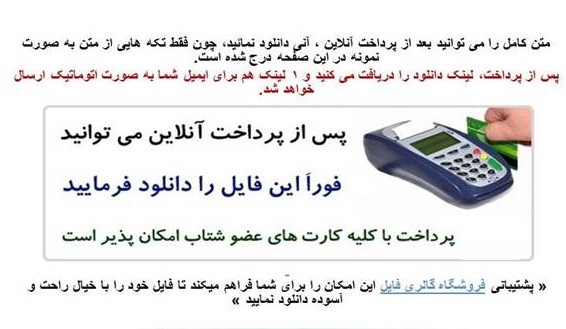لینک دانلود و خرید پایین توضیحات
فرمت فایل word و قابل ویرایش و پرینت
تعداد صفحات: 8
بتن گازی(سلولی , متخلخل) ( Cellular,Gas,Aerated concrete )
واژه عمومی برای بتن حاوی تعداد زیادی سلولهای کوچک هوا می باشد. ( استاندارد ملی 8084- بند 4-20)
بتن سلولی
این بتن از ترکیب سیمان –ماسه بادی – آب و کف تولید شده توسط مواد شیمایی بدست می آید ماده کف زا در دستگاه مخصوص تولید حبابهای پایدارهوا نموده که پس از اختلاط با سایر اجزاء بتن به صورت خمیر روان در خواهد آمد خمیر حاصله پس از قالبگیری و یا استفاده در جا خشک و آماده بهره برداری میگردد. وزن مخصوص نهایی بین 300تا 1600 کیلو گرم به متر مکعب وابسته به میزان هوای موجود در بتن خواهد بود.
خواص بتن سلولی
ضریب انتقال حرارت پایین این بتن آنرا به عایق موثر در مقابل حرارت تبدیل نموده و باعث جلوگیری از هدر رفتن انرژی در جدارها و کف و سقف ساختمان می نماید ضمن آنکه سبکی وزن باعث کم شدن بار ساختمان گردیده و از مخارج فنداسیون و اسکلت می کاهد از خواص دیگرآن میتوان به مقاومت در برابر صوت و خاصت آگوسیتی آن اشاره کرد که باعث رفاه ساکنین می گردد. این نوع بتن دارای خواص ضد رطوبتی بوده و در برابر حریق مقاوم است.
/
بتن گازی به دو زیر گروه : 1- فوم بتن 2-اتو کلاوی (واکنش شیمیایی) تقسیم بندی می شوند.
فوم بتن دارای فرآیند کم آب (نسبتا خمیری) بوده و فوم مصنوعی با تزریق در خمیر حاصله از مواد اولیه ،ایجاد حباب وفضای خالی می کند نسبت آب به سیمان پایین است ومعمولا پس از گیرش در محیط معمولی یا حداکثر گرم خانه عمل آوری تکمیل شده ومحصول آماده بهره گیری خواهد بود. مواد پایه فوم بتن ترکیبی از ماسه نرم طبیعی،سیمان، آب ، الیاف پروپیلن ونوعی از ماده کف زا می باشد ماده کف زا ضمن اختالاط با آب حباب های تولید شده را تثبیت می کند تولید کف پایدار کل مواد بایستی در میکسر ویژه اختلاط یابند که خمیر تشکیل شده یا به صورت در جا ویا در قالب قرار می گیرد. که امکان در جای آن مزیتی نسبت به نوع اتوکلاوی می باشد.
با توجه به طرح اختلاط این محصول ، فوم بتن می تواند حتی سبکتر از نوع اتوکلاوی باشد.80 kg/m² هبلکس 70 kg/m² فوم بتن سایر مشخصات نیز برطبق شرایط طرح اختلاط متغیر است.زیر گروه دوم دارای فرآیند تولید دوغابی بوده وایجاد تخلخل ناشی از واکنش شیمیایی یک عامل حباب ساز(معمولا پودر آلومینیوم) با محیط رقیق وقلیلایی ایجاد شده در فرآیند تولید می باشد. نسبت آب به سیمان بالاتر از نوع قبلی بوده وعمل آوری نهایی تحت فشار وحرارت اتوکلاو (عمدتا 14 اتمسفر و180 درجه سانتی گراد )انجام می پذیرد. به همین دلیل پسوند اتوکلاوی به آن اضافه می شود.این گروه نسبت به نوع فوم بتن دارای خواص نسبی بهتری می باشد از جمله مقاومت بالاتر،بافت متخلخل مناسبتر رنگ روشن تر وضریب انتقال حرارت پایین تر با در نظر گرفتن اینکه فرآیند تولید آن نیز گرانتر وپیچیده تر از فوم بتن می باشد.از مشکلات استفاده از بتن های سبک فومی واتو کلاوی:1-شرینکیج ناشی از خشک شدن پلاستر گچی که باعث ایجاد ترک در سطح پلاستر می شود. لازم است قبل از اجراء بلوکها کاملا خیس شده تاجذب آب اولیه ظرفیت جذب آب ملات ویا پلاستر گچی را کاهش داده ومانع شرینکیچ مخرب شود.( به علت جذب آب بالای بتن سبک)2-شکستگی در حین جابه جایی وانتقالاتمقایسه مواد تشکیل دهنده فوم بتن وبتن اتوکلاوی فوم بتن :بتن حامل از اختلاط ترکیبی : ماسه نرم طبیعی ،آب، الیاف پروپیلن (در بعضی از بتن های فومی الیاف وجود ندارد)بتن اتوکلاوی: از طریق اختلاط وپخت مواد اولیه : ماسه سیلیسی،آهک،سیمان، آب وپودر آلومینیوم تهیه می شود.
بلوکهای سیمانی تو خالی ته پر
از مخلوط سبکدانه ، ریزدانه، سیمان و آب بدست می آید و نسبتا متخلخل است. مقاومت فشـاری آن حداقل 20 کیلو گرم بر سانتی متر مربع می باشد.
بلوک بتن گازی تو پر
ویژگی های بتن گازی
بتن گازی در واقع شامل 50% هواسـت که این روزنه ها بطور منظم براسـاس حجم خود توزیع شـده اند این بتـن از مـواد چسـبانـنـده، خرده سنـگریزه ها، آب و افزود نـیهای مخصوص تهیه می شـود خواص اصـلی بتـن گازی اعـم ازاستحکام، قابلیت هدایت گرما و.. را میتوان در قابلیت

تحقیق درمورد بتن گازی 8ص





